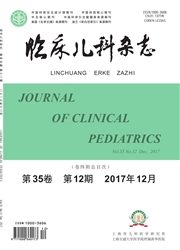

 中文摘要:
中文摘要:
目的探讨整合素连接激酶(ILK)/磷酸化蛋白激酶B(Akt)信号通路在新生鼠缺氧缺血性脑损伤(HIBD)修复中的作用。方法采用10日龄SD新生大鼠随机分为假手术组铆=3)和缺氧缺血组(HI组,n=23),建立HIBD模型,于HI后0、4、6、12、24、48、72h处死取脑,免疫荧光法检测ILK表达与分布,Westernblot检测ILK、Akt、磷酸化蛋白激酶B(p-Akt)、血管内皮生长因子(VEGF)的表达情况。构建靶向ILKRNA干扰的慢病毒载体,抑制新生鼠脑组织中ILK的表达。右侧侧脑室分别注射含有LV-ILKshRNA慢病毒(n=15)和LV-control慢病毒对照(n=3),建立HIBD模型,于HI后4h和24h处死动物取脑,Westernblot检测ILK、Akt、p-Akt、VEGF蛋白的表达变化,TUNEL染色检测细胞凋亡。结果ILK主要表达于皮层和海马区,定位于胞浆和胞膜,在假手术组和HI组均有表达。ILK于HI后表达开始逐渐增加,24h达高峰,之后表达有所降低。p-Akt于HI后4h明显增加,后逐渐降低,24h降至最低,后又增加,在48h达高峰。VEGF于HI后4h表达开始增加,12h达高峰,后维持较高水平。构建的靶向ILKRNA干扰的慢病毒载体在体内应用获得成功。注射慢病毒LV-ILKshRNA组在HI4h、24h时所表达的ILK、p-Akt、VEGF均明显低于同一时间点的LV-control组,同时细胞凋亡明显增加。结论新生大鼠HIBD后,ILK、p-Akt、VEGF蛋白表达均增高,通过抑制ILK的表达,能够降低新生大鼠HIBD后p-Akt和VEGF蛋白表达,增加细胞凋亡。提示HIBD后可能通过ILK/Akt信号通路,增加VEGF表达,进而促进神经细胞存活及血管再生,在新生鼠HI脑损伤修复中发挥作用。
 英文摘要:
英文摘要:
Objective To investigate the possible function of integrin-linked kinase (ILK) / protein kinase B (PKB/Akt) signaling in repair of neonatal rat hypoxia-ischemia brain damage (HIBD). Methods Postnatal day 10 SD rats were randomly divided into hypoxia ischemia (HI) group and sham control group. Rat brains were collected at 0 h, 4 h, 6 h, 12 h, 24 h, 48 h and 72 h after hypoxia ischemia damage. Immunofluorescence staining was used to observe the distribution and expression of ILK. Western blot was used to detect the expression of ILK, Akt, phosphorylated Akt (p-Akt) and vascular endothelial growth factor (VEGF). Lentiviral vectors expressing ILK shRNA were constructed to inhibit the expression of ILK in neonatal rats. After intracerebroventricular injections of LV-ILK shRNA lentivirns and LV-control respectively, HIBD model was established. Rat brains were collected at 4 h and 24 h after HIBD. Western blot was used to detect the expression of ILK, p-Akt, and VEGF. TdT-mediated dUTP-biotin nick end labeling (TUNEL) staining was used to detect cell apoptosis. Results Immunofluorescence staining showed that ILK was widely distributed in cortex and hippocampus both in HI group and sham control group. ILK located at cell membrane and cytoplasm. Western blot results demonstrated that ILK protein increased after HI, with a peak at 24 h, and maintained higher level than those in sham control group. The p-Akt protein significantly increased at 4 h after HI, and significantly decreased in the following 24 h, and then increased again, with a peak at 48 h, but the level of p-Akt protein was higher than that of sham control group. The VEGF protein increased at 4 h after HI, with a peak at 12 h, higher than that of sham control group. The expression of Akt protein showed no significant difference between HI group and sham control group. Lentiviral vectors containing RNAi targeting ILK was applied successfully in vivo. At 4 h and 24 h after H1BD model, the expression of ILK, p-Akt, and VEGF proteins in
 同期刊论文项目
同期刊论文项目
 同项目期刊论文
同项目期刊论文
 Risk Factors and Prognosis of Atrioventricular Block After Atrial Septum Defect Closure Using the Am
Risk Factors and Prognosis of Atrioventricular Block After Atrial Septum Defect Closure Using the Am Role of mammalian target of rapamycin in hypoxic or ischemic brain injury: potential neuroprotection
Role of mammalian target of rapamycin in hypoxic or ischemic brain injury: potential neuroprotection Involvement of the Akt/GSK-3β/CRMP-2 pathway in axonal injury after hypoxic-ischemic brain damage in
Involvement of the Akt/GSK-3β/CRMP-2 pathway in axonal injury after hypoxic-ischemic brain damage in MiR-199a-3p Inhibits Aurora Kinase A and Attenuates Prostate Cancer Growth New Avenue for Prostate C
MiR-199a-3p Inhibits Aurora Kinase A and Attenuates Prostate Cancer Growth New Avenue for Prostate C Microarray Profiling and Co-Expression Network Analysis of LncRNAs and mRNAs in Neonatal Rats Follow
Microarray Profiling and Co-Expression Network Analysis of LncRNAs and mRNAs in Neonatal Rats Follow Biological characteristics of prostate cancer cells are regulated by hypoxia-inducible factor 1 alph
Biological characteristics of prostate cancer cells are regulated by hypoxia-inducible factor 1 alph Involvement of the Akt-GSK-3β-CRMP-2 pathway in axonal and dendritic injury after hypoxic-ischemic b
Involvement of the Akt-GSK-3β-CRMP-2 pathway in axonal and dendritic injury after hypoxic-ischemic b 期刊信息
期刊信息
